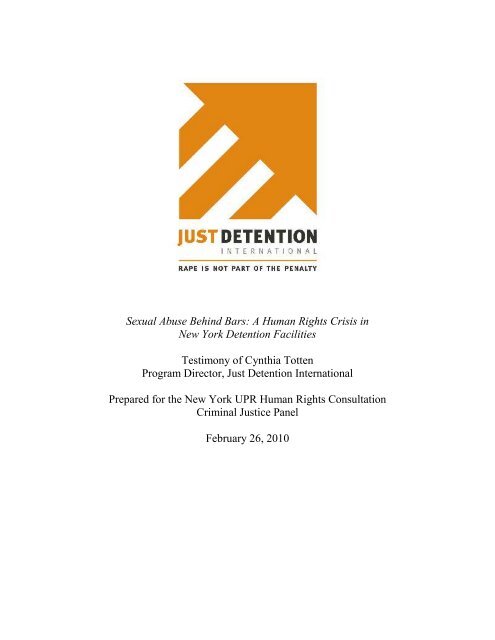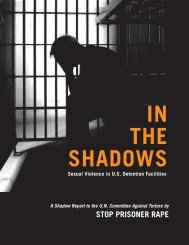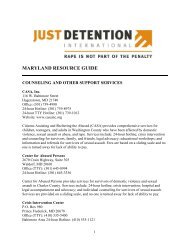Sexual Abuse Behind Bars - Just Detention International
Sexual Abuse Behind Bars - Just Detention International
Sexual Abuse Behind Bars - Just Detention International
You also want an ePaper? Increase the reach of your titles
YUMPU automatically turns print PDFs into web optimized ePapers that Google loves.
<strong>Sexual</strong> <strong>Abuse</strong> <strong>Behind</strong> <strong>Bars</strong>: A Human Rights Crisis in<br />
New York <strong>Detention</strong> Facilities<br />
Testimony of Cynthia Totten<br />
Program Director, <strong>Just</strong> <strong>Detention</strong> <strong>International</strong><br />
Prepared for the New York UPR Human Rights Consultation<br />
Criminal <strong>Just</strong>ice Panel<br />
February 26, 2010
Good afternoon, and thank you to the U.S. State Department and the other<br />
agencies represented here today for convening this consultation in connection with the<br />
United States’ participation in the UN Human Rights Council’s Universal Periodic<br />
Review. I am a Program Director with <strong>Just</strong> <strong>Detention</strong> <strong>International</strong> (JDI).<br />
Formerly known as Stop Prisoner Rape, JDI is an international human rights<br />
organization, and the only U.S. organization exclusively dedicated to ending sexual<br />
violence in detention. All of JDI ’s work takes place within the framework of<br />
international human rights laws and norms. Specifically, we work to ensure government<br />
accountability for prisoner rape; to transform ill-informed public attitudes about sexual<br />
violence in detention; and to promote access to resources for those who have survived<br />
this form of abuse. All of these efforts are guided by the expertise of men, women, and<br />
children who have endured sexual violence behind bars and who have been brave enough<br />
to share their experiences with us.<br />
I. <strong>Sexual</strong> <strong>Abuse</strong> in U.S. <strong>Detention</strong> Facilities<br />
<strong>Sexual</strong> abuse behind bars is a widespread human rights crisis in prisons, jails, and<br />
juvenile facilities across the U.S. According to the best available research, 20 percent of<br />
inmates in men’s prisons are sexually abused at some point during their incarceration. 1<br />
The rate for women’s facilities varies dramatically from one prison to another, with one<br />
in four inmates being victimized at the worst institutions. 2<br />
In a 2007 survey of prisoners across the country, the U.S. Department of <strong>Just</strong>ice’s<br />
Bureau of <strong>Just</strong>ice Statistics (BJS) found that 4.5 percent (or 60,500) of the more than 1.3<br />
million inmates held in federal and state prisons had been sexually abused in the previous<br />
1
year alone. 3 A BJS survey in county jails was just as troubling; nearly 25,000 jail<br />
detainees reported having been sexually abused in the past six months. 4<br />
In its recent survey of youth in juvenile detention, the BJS found that a shocking<br />
12.1 percent—almost one in eight—of youth reported being abused at their current<br />
facility in the past year. In the worst facilities, the rate was as high as 30 percent. 5 A 2005<br />
BJS study of sexual abuse reported in adult prisons and jails found that young inmates<br />
were at heightened risk for abuse in these facilities as well. 6 Although the Juvenile <strong>Just</strong>ice<br />
and Delinquency Prevention Act prohibits detaining juveniles with adults except in very<br />
limited circumstances, 7 this protection does not apply to youth who are prosecuted as<br />
adults. 8<br />
II.<br />
Focus on <strong>Sexual</strong> <strong>Abuse</strong> in New York Corrections Facilities<br />
<strong>Sexual</strong> abuse of prisoners—a human rights crisis in facilities across the country—<br />
pervades New York detention facilities as well. For example, two of the five New York<br />
state prisons included in the 2007 BJS survey of inmates in state and federal facilities had<br />
rates of abuse substantially higher than the national rate. At Wende Correctional Facility,<br />
in Erie County, 6.4 percent of inmates surveyed reported having experienced sexual<br />
abuse within the preceding 12 months. At Great Meadow Correctional Facility in<br />
Comstock, the rate was 11.8 percent. 9<br />
Very high rates of abuse have also been documented in New York jails: at both<br />
the Franklin County Jail and New York City’s Rose M. Singer Center, more than seven<br />
percent of jailed inmates surveyed as part of the BJS’ 2007 national survey reported that<br />
they had experienced sexual abuse within the preceding six months, compared with a<br />
national rate of more than three percent. 10<br />
2
As in other parts of the country, gay and transgender inmates in New York<br />
corrections facilities are at a disproportionately high risk of sexual abuse. Take the case<br />
of a transgender woman whom I shall refer to using her initials, “D.W.” From May<br />
through October 2008, while incarcerated at the Shawangunk Correctional Facility, a<br />
men’s prison in Ulster County, D.W. experienced ongoing sexual harassment and abuse<br />
at the hands of another inmate. 11 Because of her assailant’s threats, D.W. feared for her<br />
safety and felt that it was too dangerous to report the abuse.<br />
When D.W. eventually decided she had no choice but to report the abuse, she<br />
hoped that corrections officials would immediately take steps to ensure her safety,<br />
provide treatment for the physical injuries she had suffered during the most recent sexual<br />
assault, and conduct a thorough investigation. Instead, in violation of agency policy,<br />
D.W. was charged with a disciplinary infraction for having engaged in a sexual act, based<br />
on the investigating officer’s flawed impression that the sexual conduct between D.W.<br />
and the assailant was “more consensual than it was….rape.” 12<br />
As we hear in letters <strong>Just</strong> <strong>Detention</strong> <strong>International</strong> receives from inmates around<br />
the nation every week, incidents like these are far from rare. Corrections officials often<br />
conflate homosexuality and transgender identity with consent to rape, contributing to an<br />
environment in which sexual abuse thrives, and in which vulnerable inmates are left with<br />
nowhere to turn.<br />
As evidenced by the Amador case, a class action lawsuit brought on behalf of<br />
women inmates who were sexually abused by male staff while incarcerated in New York<br />
prisons, such abuse by corrections officials continues to be rampant in the state’s<br />
detention facilities. 13 Moreover, that case underscores that even when inmates have the<br />
3
courage to come forward—including when multiple instances of abuse by the same<br />
official have been reported—it is rare that appropriate administrative and criminal<br />
sanctions are imposed. One of the defendants in Amador had multiple prior complaints<br />
lodged against him year after year; only when a woman inmate had sperm on her shirt<br />
after being forced to perform oral sex was he terminated from employment and criminal<br />
charges finally brought. 14<br />
III.<br />
The U.S.’ Obligation to Address <strong>Sexual</strong> <strong>Abuse</strong> <strong>Behind</strong> <strong>Bars</strong><br />
The sexual assault of prisoners, whether perpetrated by corrections officials or by other<br />
inmates, amounts to torture under international law. Torture is prohibited by Article 5 of<br />
the Universal Declaration of Human Rights, along with international conventions and<br />
treaties, including the Convention Against Torture and Other Cruel, Inhuman or<br />
Degrading Treatment or Punishment (CAT) 15 and the <strong>International</strong> Covenant on Civil<br />
and Political Rights (ICCPR), 16 both of which have been ratified by the U.S.<br />
In 2006, the CAT Committee and the Human Rights Committee reviewed U.S.<br />
compliance with the CAT and the ICCPR respectively. Both committees recognize sexual<br />
violence in detention as part of their mandate and have identified it as a serious problem<br />
in the U.S. The CAT Committee commended certain U.S. initiatives, including the<br />
enactment of the Prison Rape Elimination Act of 2003, which calls for a “zero-tolerance”<br />
standard for rape in U.S. detention facilities. 17 However, the Committee detailed<br />
numerous concerns with U.S. policy and practice, including the failure to prevent sexual<br />
abuse of gay and transgender inmates and the failure to investigate instances of prisoner<br />
rape in a prompt and transparent manner. 18<br />
4
The Human Rights Committee also commended the adoption of PREA, but<br />
expressed concern that male officers continue to have full access to women’s detention<br />
quarters. 19 The Committee also noted its concern about widespread hate crimes<br />
committed against lesbian, gay, bisexual, transgender, and queer (LGBTQ) individuals,<br />
including by law enforcement. 20<br />
IV.<br />
Recommendations<br />
Rape is not an inevitable part of prison life. On the contrary, when effective policies are<br />
in place and fully implemented, sexual violence can be prevented. In December 2010, the<br />
human rights record of the U.S. will be reviewed during a Universal Periodic Review<br />
(UPR), at which point the Office of the High Commissioner on Human Rights will call<br />
upon the U.S. to specify what actions it has taken to improve the human rights situation<br />
and to overcome challenges to the universal enjoyment of human rights. With the UPR<br />
examination approaching, JDI calls on the U.S. to fulfill its international human rights<br />
obligations by taking the following measures:<br />
• Ratify the Optional Protocol to the Convention Against Torture, a critical tool<br />
in improving external oversight of detention facilities.<br />
• Implement fully the Convention Against Torture (CAT) and the ICCPR,<br />
including by permitting Article 22 communications under the CAT.<br />
• Adopt swiftly the standards for preventing, detecting, responding to and<br />
monitoring sexual abuse behind bars developed pursuant to the Prison Rape<br />
Elimination Act of 2003.<br />
These actions will help restore U.S. standing as a human rights leader and significantly<br />
improve safety for the incarcerated adults and children at risk of sexual violence in New<br />
York and around the nation.<br />
Thank you.<br />
5
1 Cindy Struckman-Johnson et al., <strong>Sexual</strong> Coercion Reported by Men and Women in Prison, 33 J. Sex Res.<br />
67 (1996); see also Cindy Struckman-Johnson & David Struckman-Johnson, <strong>Sexual</strong> Coercion Rates in<br />
Seven Midwestern Prison Facilities for Men, 80 Prison J. 379, 383 (2000).<br />
2 Cindy Struckman-Johnson & David Struckman-Johnson, <strong>Sexual</strong> Coercion Reported by Women in Three<br />
Midwestern Prison, 39 J. Sex Res. 217, 220 (2002).<br />
3 ALLEN J. BECK & PAIGE M. HARRISON, BUREAU OF JUSTICE STATISTICS, SEXUAL VICTIMIZATION IN<br />
STATE AND FEDERAL PRISONSREPORTED BY INMATES, 2007 (2007).<br />
4 ALLEN J. BECK & PAIGE M. HARRISON, BUREAU OF JUSTICE STATISTICS, SEXUAL VICTIMIZATION IN<br />
LOCAL JAILS REPORTED BY INMATES, 2007 (2008).<br />
5<br />
ALLEN BECK, PAIGE HARRISON & PAUL GUERINO, BUREAU OF JUSTICE STATISTICS, SEXUAL<br />
VICTIMIZATION IN JUVENILE FACILITIES REPORTED BY YOUTH 2008-2009 1 (2010).<br />
6 ALLEN J. BECK & PAIGE M. HARRISON, BUREAU OF JUSTICE STATISTICS, SEXUAL VIOLENCE REPORTED<br />
BY CORRECTIONAL AUTHORITIES, 2005 (2006).<br />
7 42 U.S.C. § 5633 (a) (13), (14). State delinquency agencies that fail to comply with this and other<br />
requirements within the Juvenile <strong>Just</strong>ice and Delinquency Prevention Act will lose their federal funding.<br />
8 Three states consider 16 year olds to be adults as a matter of law; 10 states define 17 year olds as adults,<br />
and all states have provisions within their criminal justice laws allowing for youth who commit certain<br />
crimes and/or have prior contacts with the juvenile and criminal justice systems to be treated as adults. See<br />
Christopher Hartney, National Council on Crime and Delinquency, Fact Sheet, Youth Under Age 18 in the<br />
Adult Criminal <strong>Just</strong>ice System (2006).<br />
9 Supra, note 3 at p. 18.<br />
10 Supra, note 4 at p. 2.<br />
11 Petitioner’s Memorandum of Law in Support of Petition for Relief Pursuant to CPLR Article 78 at 2, In<br />
the Matter of D.W. v. Brian Fischer, New York State Department of Correctional Services Commissioner<br />
(2009) (No. 3127-09).<br />
12 Id. at 4.<br />
13 <strong>Sexual</strong> abuse against youth in New York juvenile facilities has also been well-documented. See HUMAN<br />
RIGHTS WATCH & THE AMERICAN CIVIL LIBERTIES UNION (ACLU), CUSTODY AND CONTROL: CONDITIONS<br />
OF CONFINEMENT IN NEW YORK’S JUVENILES PRISONS FOR GIRLS 63-64 (2005).<br />
14 Amador, et al., v. Andrews, et al., 03-Civ.-0650 (KTD) (GWG) (S.D.N.Y. 2003).<br />
15 Convention Against Torture and Other Cruel, Inhuman or Degrading Treatment or Punishment<br />
(“Convention Against Torture”), G.A. Res.39/46, 39 U.N. GAOR, 39th Sess., Supp. No. 51, at 197, U.N.<br />
Doc. A/39/51 (1984) (entered into force June 26, 1987 and ratified by the U.S. Oct. 14, 1994).<br />
16 <strong>International</strong> Covenant on Civil and Political Rights, adopted Dec. 16, 1966, 999 U.N.T.S. 171 (entered<br />
into force March 23, 1976 and ratified by the U.S. June 8, 1992).<br />
17 Committee Against Torture, 36th Session, Consideration of Reports Submitted by States Parties under<br />
Article 19 of the Convention, CAT/C/USA/CO/2, at 9, 32 (citing the Prison Rape Elimination Act, 42<br />
U.S.C. §15601, et seq.).<br />
18 Id. The concerns about sexual violence raised by the Committee Against Torture are detailed further in a<br />
“shadow report” that <strong>Just</strong> <strong>Detention</strong> <strong>International</strong> (then called Stop Prisoner Rape) submitted to the<br />
Committee. See Stop Prisoner Rape, In the Shadows: <strong>Sexual</strong> Violence in U.S. <strong>Detention</strong> Facilities (2006).<br />
19 Human Rights Committee, 87th Session, Consideration of Reports Submitted by States Parties under<br />
Article 40 of the Covenant, CCPR/C/USA/CO/3/Rev.1, at 33.<br />
20 Id. at 25. To learn more about the specific dangers of LGBTQ detainees, see <strong>Just</strong> <strong>Detention</strong><br />
<strong>International</strong>, Fact Sheet, LGBTQ Detainees Chief Targets for <strong>Sexual</strong> <strong>Abuse</strong> in <strong>Detention</strong> (2009).<br />
6





